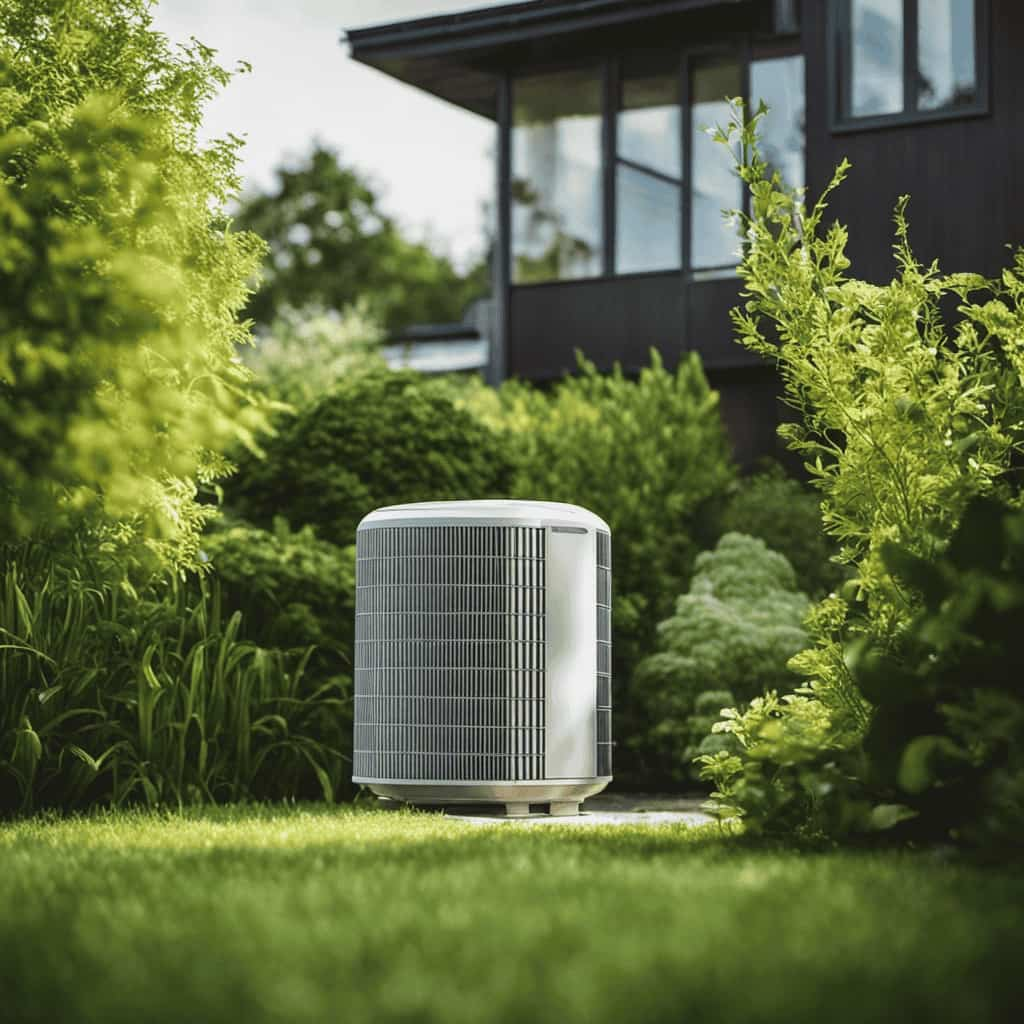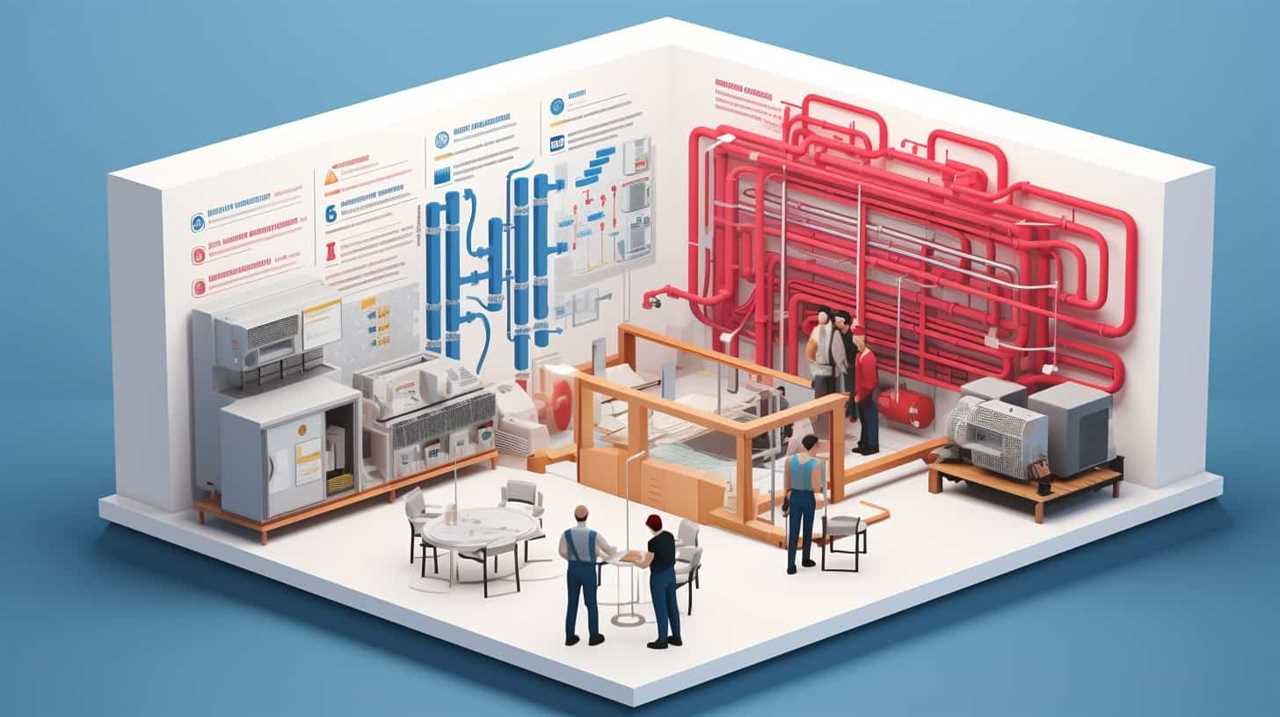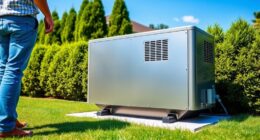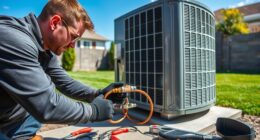Are you ready to efficiently oversee the performance of your heat pump?
In this article, we will show you how to effectively maintain your heat pump refrigeration cycle. Just like a well-oiled machine, your heat pump requires regular TLC to keep it running smoothly and efficiently.
We will guide you through the process step by step, from understanding the refrigeration cycle to cleaning and inspecting essential components.
By following our expert tips, you can ensure optimal performance and prolong the lifespan of your heat pump.

Let’s get started!
Key Takeaways
- Regular maintenance is important for optimal performance and longevity of the heat pump refrigeration cycle.
- Understanding the refrigeration cycle and temperature-pressure relationship is crucial for maintaining efficiency and energy consumption.
- Troubleshooting common issues such as electrical problems, leaks, and system performance abnormalities is necessary.
- Cleaning and maintenance procedures include inspecting the evaporator coil, checking and replacing refrigerant levels, lubricating moving parts, and cleaning the condenser coil.
Importance of Regular Maintenance
Regular maintenance is essential for ensuring the optimal performance and longevity of our heat pump refrigeration cycle. The importance of regular maintenance can’t be overstated.
By regularly servicing our heat pump, we can prevent potential problems before they arise, saving us time, money, and inconvenience in the long run. Regular maintenance allows us to identify and address any issues early on, preventing them from escalating into major breakdowns that require costly repairs or replacements.
Additionally, regular servicing helps to improve the energy efficiency of our heat pump, resulting in reduced energy consumption and lower utility bills. It also helps to maintain the air quality in our living spaces by ensuring that the system is clean and free from dust, allergens, and pollutants.

Understanding the Refrigeration Cycle
Let’s begin by understanding the key components of the refrigeration cycle.
This cycle involves four main components: the compressor, condenser, expansion valve, and evaporator. Each of these components plays a crucial role in the heat transfer process.
Key Cycle Components
We need to understand the key cycle components to effectively maintain the refrigeration cycle in our heat pump. By familiarizing ourselves with these components, we can troubleshoot any issues that may arise and ensure the optimal functioning of our heat pump system.
To help you visualize the key cycle components, here is a table outlining their functions and importance:

| Component | Function |
|---|---|
| Compressor | Increases the pressure and temperature of the refrigerant |
| Condenser | Transfers heat from the refrigerant to the surrounding air or water |
| Expansion Valve | Controls the flow of refrigerant into the evaporator |
| Evaporator | Absorbs heat from the surrounding air or water, cooling it down |
| Refrigerant | Transfers heat between the different cycle components |
Understanding these components and their roles in the refrigeration cycle is vital for effective maintenance and troubleshooting techniques. By regularly inspecting and maintaining these components, we can ensure the efficient operation of our heat pump system and extend its lifespan.
Temperature and Pressure Relationship
How does the temperature and pressure relationship contribute to our understanding of the refrigeration cycle in maintaining our heat pump?
In order to effectively maintain our heat pump refrigeration cycle, it’s crucial to understand the relationship between temperature and pressure. This relationship is fundamental to the functioning of the cycle and plays a vital role in temperature regulation and the proper operation of the heat pump.
In the refrigeration cycle, the refrigerant properties are key factors in achieving efficient heat transfer. As the refrigerant moves through the system, it undergoes phase changes and experiences variations in temperature and pressure. These changes allow the refrigerant to absorb heat from the surrounding environment and release it elsewhere.

By manipulating the temperature and pressure levels, we can control the heat transfer process and achieve the desired cooling or heating effect in our heat pump.
Understanding the temperature and pressure relationship is essential for maintaining optimal performance and energy efficiency in our heat pump refrigeration cycle. Proper temperature and pressure regulation ensure that the system operates within the recommended specifications, leading to increased durability and reduced energy consumption.
Troubleshooting Common Issues
When troubleshooting common issues with the refrigeration cycle, we need to understand the fundamental principles of how it operates. Here are three important steps to follow when troubleshooting electrical issues and checking for leaks in your heat pump refrigeration cycle:
- Electrical Issues:
- Start by checking the power supply to ensure that the heat pump is receiving the required voltage.
- Inspect the electrical connections for any loose or damaged wires.
- Use a multimeter to test the components such as the compressor, fan motors, and control boards for proper functioning.
- If you find any faulty electrical components, they may need to be replaced.
- Leaks:
- Inspect the refrigerant lines and connections for any signs of leakage.
- Look for oil stains or wet spots around the components.
- You can use a refrigerant leak detector or soapy water to identify any leaks.
- If a leak is detected, it’s important to repair it promptly to prevent further damage to the system.
- System Performance:
- Monitor the temperature and pressure readings in the refrigeration cycle.
- Compare them to the manufacturer’s specifications to ensure that the system is operating within the recommended range.
- If the readings are abnormal, it could indicate a problem with the refrigerant charge, airflow, or component malfunction.
Cleaning and Inspecting the Evaporator Coil
To ensure optimal performance, regularly clean and inspect the evaporator coil at least once every six months.

Cleaning the evaporator coil is crucial as it helps maintain the efficiency of the heat pump refrigeration cycle.
Start by turning off the power supply to the heat pump.
Gently remove the coil access panel and use a soft brush or vacuum cleaner to remove any accumulated dirt, dust, or debris.
Be careful not to damage the coil fins or coils themselves.

Pay close attention to signs of damage such as bent fins or leaks.
If any damage is detected, it’s important to contact a professional for repair or replacement.
Regular cleaning and inspection of the evaporator coil will help extend the lifespan of your heat pump and ensure efficient operation.
Checking and Replacing Refrigerant Levels
We can maintain optimal performance of our heat pump refrigeration cycle by regularly checking and replacing refrigerant levels. Proper refrigerant levels are crucial for the efficient operation of the heat pump system.

Here are three important steps to follow when checking and replacing refrigerant levels:
-
Perform a visual inspection: Start by visually inspecting the refrigerant lines and connections for any signs of leakage or damage. This includes checking for oil stains, frost or ice buildup, and any unusual sounds or smells. Any signs of leakage or damage should be addressed immediately.
-
Use a pressure gauge: Connect a pressure gauge to the service valve to measure the refrigerant pressure. Compare the readings with the manufacturer’s specifications to ensure that the refrigerant levels are within the recommended range.
-
Recharge or replace refrigerant: If the refrigerant levels are low, it’s necessary to recharge the system with the appropriate refrigerant. This should be done by a qualified technician who can accurately measure and add the correct amount of refrigerant to the system.

Regularly checking and replacing refrigerant levels will help ensure the efficient and reliable operation of your heat pump system. It’s essential to follow manufacturer guidelines and seek professional assistance when needed to maintain optimal performance.
Lubricating the Heat Pump’s Moving Parts
By regularly lubricating the heat pump’s moving parts, we can ensure smooth and efficient operation of the system. The lubricant selection is crucial to maintain optimal performance. It’s recommended to use a high-quality lubricant specifically designed for heat pumps. These lubricants have excellent viscosity and thermal stability, allowing them to withstand the high temperatures and pressures within the system.
When selecting a lubricant, it’s important to consider the manufacturer’s recommendations and specifications. In terms of maintenance frequency, lubrication should be performed at regular intervals, typically every six months or as specified by the manufacturer. This ensures that the moving parts remain properly lubricated and reduces the risk of friction, wear, and damage.
Regular lubrication is a simple yet crucial step in maintaining the heat pump’s efficiency and longevity.

Cleaning and Inspecting the Condenser Coil
Regular maintenance of the condenser coil is crucial for the efficient operation of the heat pump refrigeration cycle. To effectively clean and inspect the coil, we’ll need specific tools such as a coil brush and fin comb.
Importance of Regular Maintenance
Inspecting and cleaning the condenser coil is crucial for maintaining the efficiency and performance of your heat pump refrigeration cycle. Regular maintenance of the condenser coil offers numerous benefits and should be included in your maintenance checklist. Here are three reasons why regular maintenance of the condenser coil is important:
-
Improved Heat Transfer: Over time, dirt, dust, and debris can accumulate on the condenser coil, inhibiting heat transfer. Regular cleaning ensures optimal heat transfer, allowing your heat pump to operate efficiently.
-
Prevents System Breakdowns: A dirty condenser coil can put excess strain on the system, leading to breakdowns and costly repairs. By regularly inspecting and cleaning the condenser coil, you can identify and address any potential issues before they escalate.

-
Extends Lifespan: Regular maintenance helps to prolong the lifespan of your heat pump by reducing wear and tear on critical components. Cleaning the condenser coil ensures optimal performance and prevents premature system failure.
Now that we understand the importance of regular maintenance, let’s explore the cleaning techniques and tools necessary for maintaining a clean condenser coil.
Cleaning Techniques and Tools
To effectively clean and inspect the condenser coil, we’ll need specific tools and follow proper cleaning techniques. Cleaning the condenser coil is essential for maintaining the efficiency and performance of your heat pump refrigeration cycle.
One of the cleaning techniques involves using a soft brush or a vacuum cleaner with a brush attachment to remove dirt, debris, and dust from the coil. It’s important to clean the coil gently to avoid causing damage. Additionally, using a coil cleaner solution can help remove stubborn dirt and grime.

When cleaning the condenser coil, it’s crucial to ensure that the power is turned off and the unit is disconnected. By following these cleaning techniques and utilizing the appropriate maintenance tools, you can keep your condenser coil in optimal condition.
Now, let’s move on to the next section where we’ll discuss the signs of coil damage.
Signs of Coil Damage
We should be aware of the signs of coil damage and regularly clean and inspect the condenser coil to ensure optimal performance of our heat pump refrigeration cycle. Neglecting coil maintenance can lead to reduced efficiency, increased energy consumption, and potential system breakdowns.
Here are three key signs of coil damage to watch out for:

-
Reduced cooling or heating capacity: If you notice a decrease in the efficiency of your heat pump, such as insufficient cooling or heating, it could be a sign of coil damage. The condenser coil plays a crucial role in heat transfer, and any damage can hinder this process.
-
Ice buildup: Excessive ice formation on the condenser coil is a clear indicator of damage. Ice restricts airflow and reduces the heat pump’s ability to transfer heat effectively.
-
Corrosion or physical damage: Inspect the condenser coil regularly for signs of corrosion, bent fins, or other physical damage. These issues can impede airflow and reduce the coil’s performance.
Regularly cleaning and inspecting the condenser coil will help identify and address coil damage promptly, ensuring the optimal functioning of your heat pump refrigeration cycle.

Now, let’s explore the next step in maintaining a well-performing system: ensuring proper airflow and ventilation.
Ensuring Proper Airflow and Ventilation
Let’s make sure we regularly clean the air filters and remove any debris to ensure proper airflow and ventilation in our heat pump refrigeration cycle.
Proper maintenance techniques are crucial for maximizing energy efficiency and ensuring optimal performance of our heat pump system.
Air filters play a vital role in maintaining good airflow and ventilation by trapping dust, dirt, and other contaminants that can hinder the system’s efficiency. Over time, these filters can become clogged, reducing airflow and causing strain on the system.

By cleaning or replacing the filters regularly, we can ensure unrestricted airflow, allowing the heat pump to operate at its peak performance.
Additionally, it’s important to inspect and clean the outdoor unit regularly to remove any obstructions that may impede airflow.
By taking these simple steps, we can maintain proper airflow and ventilation, promoting efficient operation of our heat pump refrigeration cycle.
Now, let’s move on to the next step: testing and calibrating thermostat settings.

Testing and Calibrating Thermostat Settings
For accurate control of our heat pump system, it’s essential to test and calibrate the thermostat settings. Proper thermostat calibration ensures that the temperature readings are accurate, leading to efficient operation and energy savings.
Here are three steps to help you troubleshoot and calibrate your thermostat:
-
Verify the thermostat accuracy: Use a reliable thermometer to compare the temperature reading on the thermostat with the actual room temperature. If there’s a significant difference, you may need to recalibrate or replace the thermostat.
-
Adjust the heat anticipator: The heat anticipator is a small metal tab inside the thermostat that controls when the heat shuts off. By adjusting this setting, you can fine-tune the temperature control and reduce temperature swings.

-
Check thermostat location: Ensure that the thermostat is installed in a central and easily accessible location away from direct sunlight, drafts, or heat sources. This will prevent false readings and ensure accurate temperature control.
Scheduling Professional Maintenance Services
Regularly scheduling professional maintenance services is crucial for ensuring the optimal performance and longevity of our heat pump system.
To keep our heat pump running efficiently, it’s important to schedule regular appointments with qualified technicians who specialize in heat pump maintenance.
Finding qualified technicians can be done by researching local HVAC companies or by asking for recommendations from friends, family, or neighbors who’ve had positive experiences with their own heat pump maintenance.

Once we’ve identified a few potential technicians, we can schedule appointments for them to come and inspect our heat pump system.
During these appointments, the technicians will perform a thorough inspection, clean and lubricate components, check refrigerant levels, test electrical connections, and ensure that the system is operating at peak efficiency.
Frequently Asked Questions
Can I Perform Regular Maintenance on My Heat Pump Myself, or Should I Always Hire a Professional?
We prefer to perform maintenance on our heat pump ourselves, but we understand the importance of professional assistance. Regular maintenance ensures optimal performance and extends the lifespan of the heat pump.
How Often Should I Clean and Inspect the Condenser Coil?
We clean and inspect the condenser coil on a regular basis to ensure optimal performance. It is important to follow the recommended frequency and maintenance tips to keep the heat pump running efficiently.

What Should I Do if I Notice a Refrigerant Leak in My Heat Pump?
If we notice a refrigerant leak in our heat pump, we should take immediate action. First, we need to detect the leak by checking for hissing sounds or oil stains. Then, we should fix the leak by replacing the damaged parts and recharging the refrigerant.
Is It Necessary to Lubricate All Moving Parts of the Heat Pump, or Are There Specific Components That Need Lubrication?
To effectively maintain our heat pump, we need to understand its lubrication requirements. Certain components, such as bearings and motors, require regular lubrication to reduce friction and prevent wear. Neglecting this maintenance can lead to increased maintenance costs.
How Can I Ensure Proper Airflow and Ventilation for My Heat Pump?
To ensure proper airflow and ventilation for our heat pump, we troubleshoot any issues that may arise. We check for obstructions, clean or replace air filters, and inspect ductwork for leaks or blockages.
Conclusion
In conclusion, regular maintenance is crucial for the effective functioning of your heat pump refrigeration cycle. By understanding the refrigeration cycle and following a methodical maintenance routine, you can ensure optimal performance and longevity of your heat pump.

Remember, ‘An ounce of prevention is worth a pound of cure.’ So, take the necessary steps to clean and inspect components, check refrigerant levels, lubricate moving parts, and schedule professional maintenance services to keep your heat pump running smoothly.









